
iuniti fórdi árt óv rídin en rítin
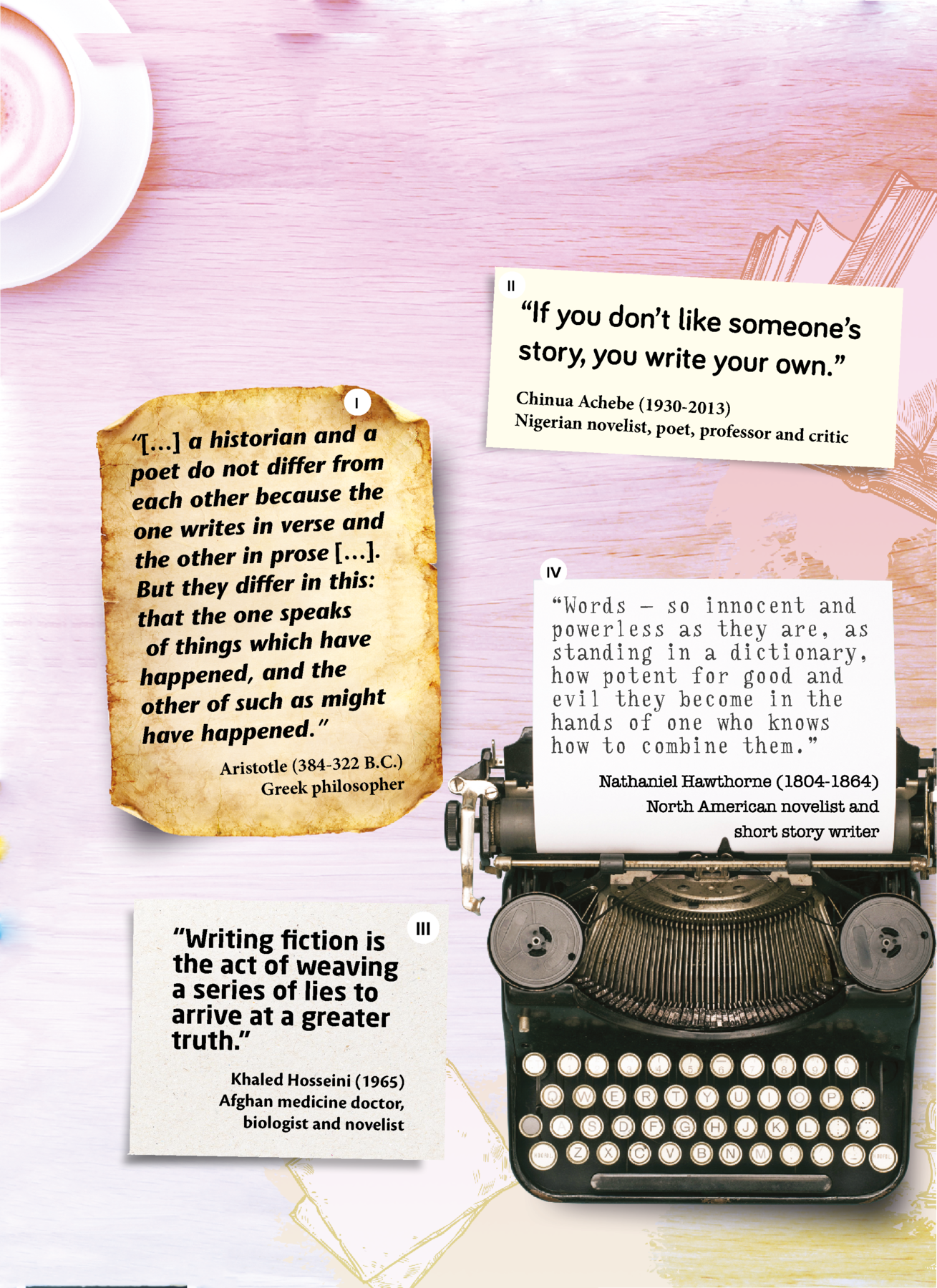
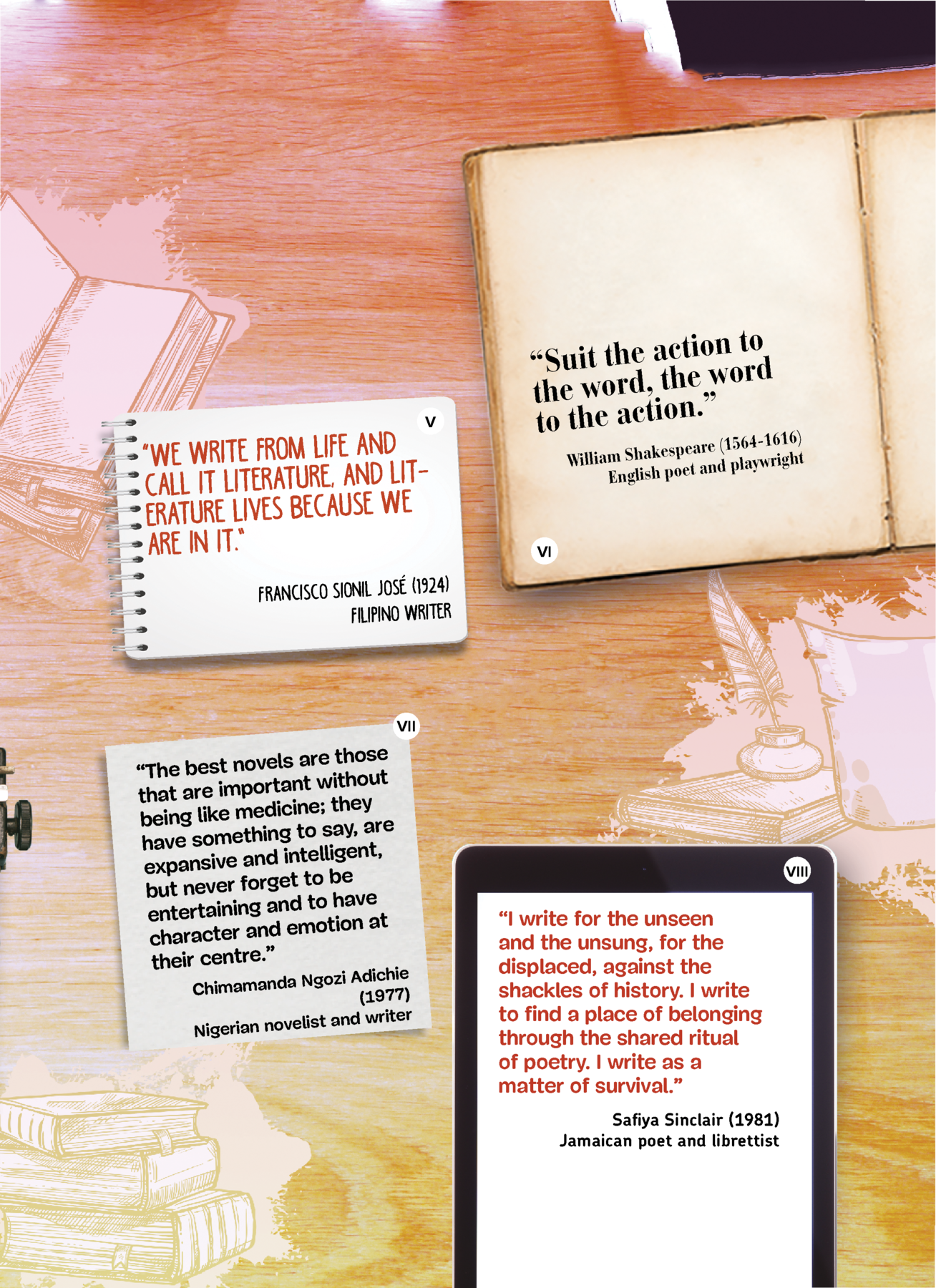
Gêneros discursivos: flash fiction (escrito e oral) e romance.
Tema: as dimensões criativas e transformadoras da escrita e da leitura.
Os objetivos desta unidade são:
- familiarizar-se com os gêneros do discurso fléxi fiquitchon (escrito e oral) e romance;
- refletir sobre como o mundo pode ser visto de perspectivas diferentes por meio da leitura para obter informação e para fruição.
taimi tchu finqui
Faça no caderno as questões de resposta escrita.


II.

III.

- O ato de ler está presente no nosso dia a dia. Vocês concordam? Por quê?
- Mencionem pelo menos cinco tipos de textos que vocês leem no dia a dia.
c. Vocês acham que os brasileiros leem pouco? Justifiquem a resposta.

-
- Vocês têm livros em casa além dos que usam para estudar? Quais? Se não têm, quais gostariam de ter?
- Vocês gostam de ler livros de contos, poesias ou romances? Por quê?
- Se vocês precisassem recomendar um livro para seu melhor amigo, que tipo de livro seria? Por quê?
- Vocês conseguem se lembrar de um livro que foi transformado em filme ou série? Qual é o título dele? Se não se lembram, encontrem um ou uma colega que se lembre e peçam a ele ou ela para contar a vocês um pouco sobre a história.

-
- Preparem-se para a entrevista. Usem as questões a seguir e adicionem outras três na lista.
- Preparem-se para a entrevista. Usem as questões a seguir e adicionem outras três na lista.
- I
- Escolha um ou uma colega de sala para realizar a entrevista.
c. Compartilhem as respostas com a turma toda. Discutam e comparem suas opiniões com a dos outros.
rídin
Faça no caderno as questões de resposta escrita.
tesqui uon
bifór rídin


2.

b. ríd tchu lârn
ríd tchu lârn
-
- t
I.
For sale: baby shoes, never worn.
O’BRIEN, E. J.; COOK, A. E.; LORCH JR., R. F. Inferences during Reading. Cambridge: Cambridge University Press, 2015. página220.
Did you know?
• O textoum, que data dos anos 1920, é geralmente atribuído a érnést remin-uei(1899-1961), romancista, escritor de microcontos e jornalista estadunidense.
II.

The Shoes
August 8, 2017 – 5 Comments
By Lynn Yvonne Moon
The dishes rattled on the shelf as a pair of black shoes bounced off the cabinet.
“I HATE MY SHOES!”
A banging bedroom door, again, rattled the dishes.
“Why don’t you buy the child a new pair of shoes?” the father, an aging man, asked his wife. “Because,” the mother replied. “It’s not the shoes.”
“It has to be the shoes,” he whispered.
The following afternoon, a pair of bright red shoes flew through the air before bouncing twice on the sofa.
“I HATE MY SHOES!” The child’s voice screeched through him like fingers against a chalkboard.
“I just bought her those shoes last night, and she loved them.” Scratching his head, the father frowned.
“It’s not the shoes.” The mother, stirring the simmering stew, had ignored her daughter’s outburst.
“If it’s not the shoes, then what is it?”
Tilting her head to one side, she replied, “Why don’t you ask her?”
“Maybe I will.” Puffing out his chest, the father knocked twice before opening his daughter’s door.
“May I ask what’s wrong with your new shoes, child?”
The little girl wiped her eyes. “I hate them!”
“Last night you said you loved them. What’s really bothering you?”
The little girl stared at the shoes, now held by her father. The sparkling red buckle brought a small smile to her otherwise teary face.
“Jessica said my shoes are stupid and ugly, and so am I.” Wiping her nose with the back of her hand, she sighed.
“And who is Jessica?”
“A mean girl on the bus.”
“Do you really hate these shoes?”
The child thought for a moment. “No…”
“I see.” He paused before adding, “Does Jessica have pretty black or red shoes?”
“No.”
“Is Jessica nice to you?”
“No.”
“Then is Jessica worth listening to?”
The child stared up at her father. Holding back a chuckle, he grinned. Fine lines running down her face, along with puffy eyes and lips, radiated an angelic haze that warmed his heart. His love and devotion for her matched by no other. It was his job to protect her. To comfort her.
“No.”
“Do you like these shoes?”
Nodding, she replied, “Yes.”
“It’s not the shoes, then.”
MOON, L. Y. The shoes. Flash Fiction Magazine. 2017. Disponível em: https://oeds.link/UMMi13. Acesso em: 20abril2022.
constrãquitchion minins

I.
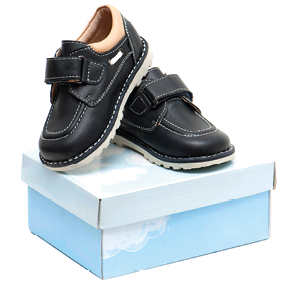
II.

d.

-
- tíéf
- umtiú
- tíéf
A The girl stopped crying.
B The little girl’s father smiled widely.
C The little girl let out a long deep breath.
D The kid looked up at her father for a long time.
E The door of the bedroom was closed with a loud noise.
-
- uér
- rú
- uót
- rráu
A Probably a room in the family’s house.
B The shoes seem to bother the little girl.
C The little girl, her parents and Jessica, a mean girl on the bus.
D Her father makes her realize that she has no reason to hate her shoes.


- tíéfdois
tésqui tchu
bifór rídin

1.
I.
“When given the choice between being right or being kind, choose kind.”
Mr. Browne, character in PALACIO, R. J. Wonder. New York: Alfred A. Knopf Books, 2012. página311.
II.
“In a world where you can be anything, be kind.”
Unknown author.
e.

2.
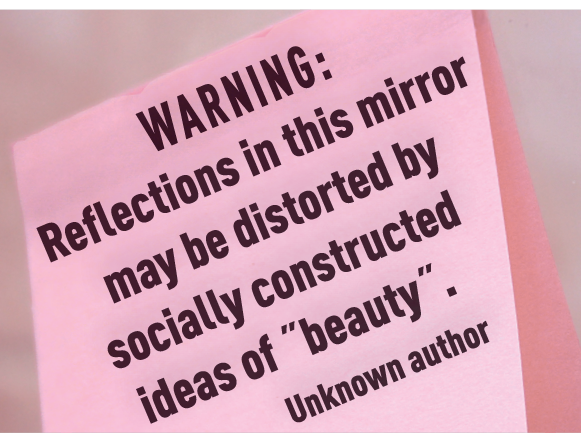
c.
3.
I.
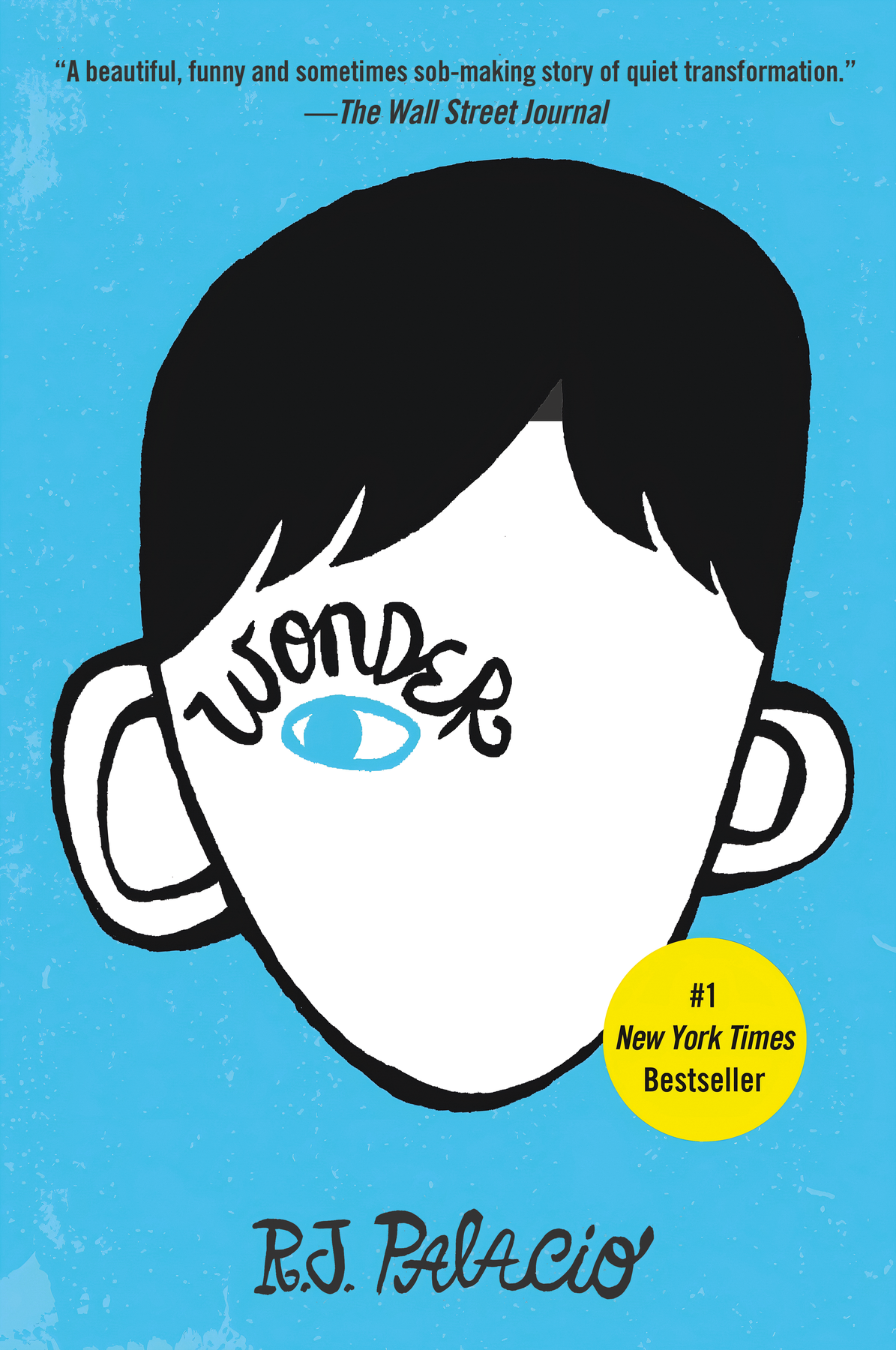
II.
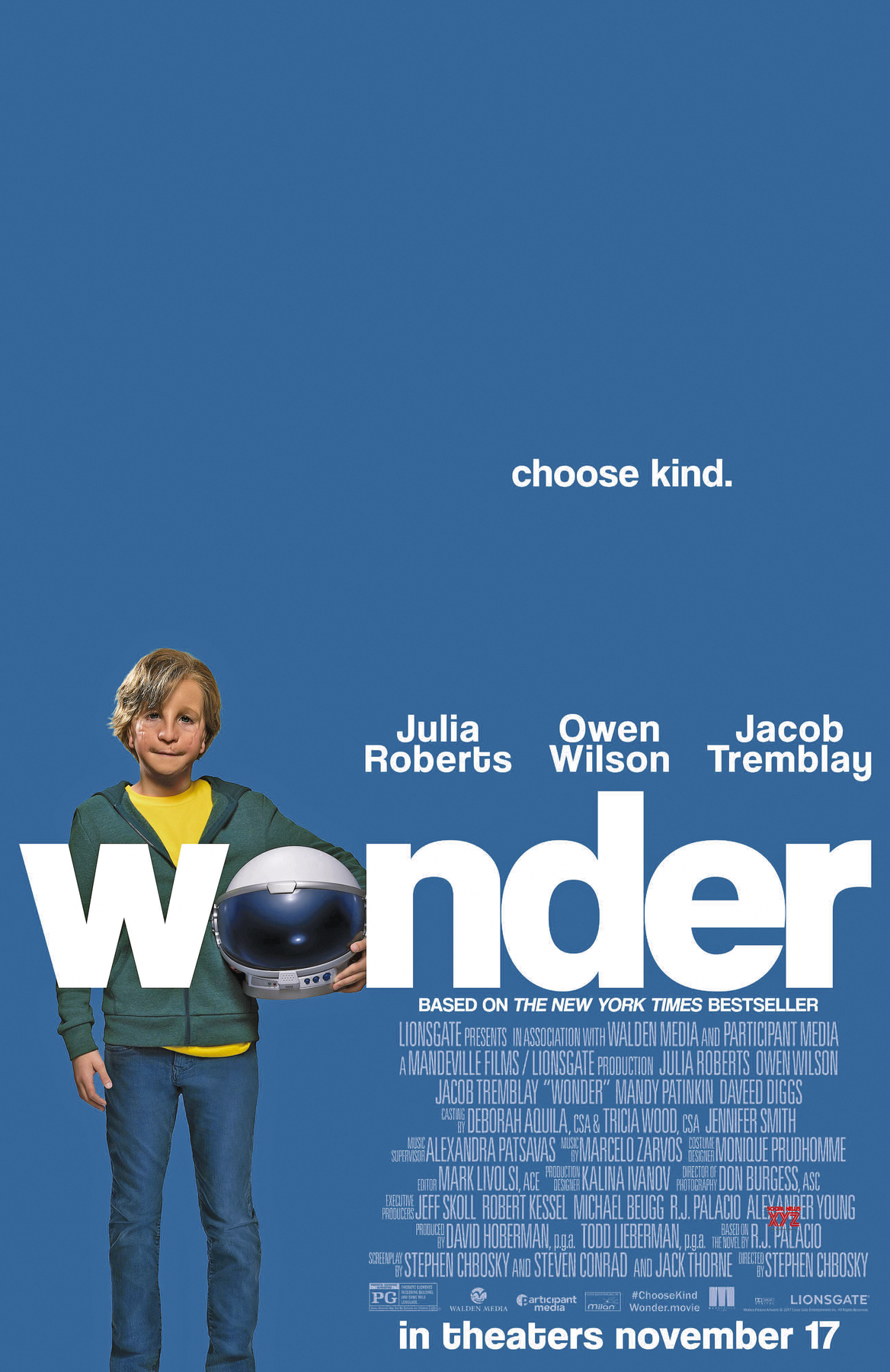
b.
Did you know?
• O livro uânder, escrito por Raquel que assina R. J. Palacio, conta a história de áugui , um menino que, por causa de uma síndrome rara, nasceu com uma deformidade facial. Quando começa sua vida escolar, áugui tenta demonstrar que é uma criança igual a todas as outras. O livro mostra como a aceitação e a gentileza podem criar relações melhores entre as pessoas. No Brasil, o livro foi publicado com o título Extraordinário.
ríd tchu lârn

Eyes on grammar – EXAMPLES 1 AND 2

I like when Mom tells this story because it makes me laugh so much. It’s not funny in the way a joke is funny, but when Mom tells it, Via and I just start cracking up. So when I was in my mom’s stomach, no one had an idea I would come out looking the way I look. Mom had had Via four years before, and that had been such a “walk in the park” (Mom’s expression) that there was no reason to run any special tests. About two months before I was born, the doctors realized there was something wrong with my face, but they didn’t think it was going to be bad. They told Mom and Dad I had a cleft palate and some other stuff going on. They called it “small anomalies.”
There were two nurses in the delivery room the night I was born. One was very nice and sweet. The other one, Mom said, did not seem at all nice or sweet. She had very big arms and (here comes the funny part), she kept farting.reticênciasMom says it was unbelievable because the nurse never even said excuse me! Meanwhile, Mom’s regular doctor wasn’t on duty that night, so Mom got stuck with this cranky kid doctor she and Dad nicknamed Doogie after some old TV show or something reticências. But Mom says that even though everyone in the room was kind of grumpy, Dad kept making her laugh all night long.
When I came out of Mom’s stomach, she said the whole room got very quiet. Mom didn’t even get a chance to look at me because the nice nurse immediately rushed me out of the room. Dad was in
such a hurry to follow her that he dropped the video camera, which broke into a million pieces. And then Mom got very upset and tried to get out of bed to see where they were going, but the farting nurse put her very big arms on Mom to keep her down in the bed. They were practically fighting, because Mom was hysterical and the farting nurse was yelling at her to stay calm, and then they both started screaming for the doctor. But guess what? He had fainted! Right on the floor! So when the farting nurse saw that he had fainted, she started pushing him with her foot to get him to wake up, yelling at him the whole time: “What kind of doctor are you? What kind of doctor are you? Get up! Get up!” And then, all of a sudden, she let out the biggest, loudest, smelliest fart in the history of farts. Mom thinks it was actually the fart that finally woke the doctor. Anyway, when Mom tells this story, she acts out all the parts – including the farting noises – and it is so, so, so, so funny!
Mom says the farting nurse turned out to be a very nice woman. She stayed with Mom the whole time. Didn’t leave her side even after Dad came back and the doctors told them how sick I was. Mom remembers exactly what the nurse whispered in her ear when the doctor told her I probably wouldn’t live through the night.And the next day, after I had lived through the night, it was that nurse who held Mom’s hand when they brought her to meet me for the first time.
Mom says by then they had told her all about me. She had been preparing herself for the seeing of me. But she says that when she looked down into my tiny mushed-up face for the first time, all she could see was how pretty my eyes were.
Mom is beautiful, by the way. And Dad is handsome. Via is pretty. In case you were wondering.
PALACIO, R. J. Wonder. Nova York: Alfred A. Knopf Books, 2012.página 6-7.
constrãquitchion minins

“Mom got stuck with this cranky kid doctor ”
“[…] she and Dad nicknamed Doogie […]”

- tíéf

3.
Versão adaptada acessível
Atividade 3.
Choose the option that substitutes the words "cracking up", "grumpy" and "yelling" without changing the meaning of the sentences from the novel.

-
- ríd tchu lârn.
- .
-
think a lítol mór

-
- Após terem lido os textos datésk uan (rídin), como vocês definiriam fléxi fiquitchon?
- Vocês acham que devemos deixar de usar uma roupa ou um calçado por causa da opinião dos outros? Por quê?
- Por causa de uma síndrome, Auggie nasceu com uma deformidade no rosto. Como devemos agir para que crianças assim não se sintam excluídas?
lissenin
Faça no caderno as questões de resposta escrita.
bifór listenin


1.


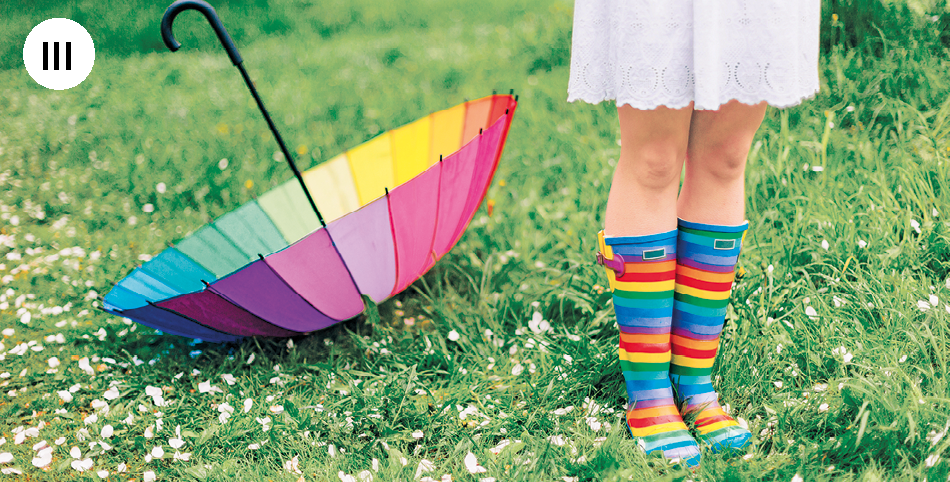


líssen tchu lârn


Eyes on grammar – EXAMPLE 1
Oral flash fiction – Parts um and dois
Title: Free as a Bird
Date: April 30, 2015
Source: Annika Sjödahl
SJÖDAHL, A. Free as a Bird sem local, sem nome 2015.
Clique no play e acompanhe a reprodução do Áudio.
Clique no play e acompanhe a reprodução do Áudio.
constrãquitchion minins

-
- ínbifór listenin


-
- tíéf
-




Versão adaptada acessível
Atividade 5, item b.
In the sentence “A bird sang a lullaby”, the word "lullaby" means
- a noise made by some animals.
- a sound produced in the woods.
- a song used to help a child go to sleep.
c.
think a lítol mór

-
- Em sua opinião, por que o título do texto é “frí és a bârd”?
- Que palavras vocês associam com liberdade? Por quê?
- Como vocês entendem a frase “lét dâ san rei intu iór laif”?
lenguagi in équitchon
Faça no caderno as questões de resposta escrita.

1.
Free as a Bird
I umespaço para resposta (want) to feel joy. Should I have the courage to leave my comfort zone? I dois espaço para resposta (have) a protective umbrella that omitted the real life from me. I was stuck under my umbrella. I stuck my hand out into the sunlight. It was warm and I três espaço para resposta (feel) courageous. I remember what my mom quatroespaço para resposta (tell) me as a child. “Stay away from the sun. It will give you skin cancer.” Then my mother cinco espaço para resposta (die) and I never left my umbrella. My umbrella was part of my everyday life. But it left me with sadness and a huge lack of vitamin D. A gust of wind left my hand empty and I shivered as a leaf. The raindrops left my skin and I seis espaço para resposta (hear) my mother in a faraway distance, “You are now a free soul. Let the sun ray into your life and live a long and happy life. I will guard you.” A bird sete espaço para resposta (sing) a lullaby.
SJÖDAHL, A. Free as a Bird.sem local, sem nome 2015.

2.
Versão adaptada acessível
Atividade 2.
Read this excerpt from the text in Task 2 (Reading) again and consider the verb forms "had fainted" and "started pushing". Which event happened first?
“So when the farting nurse saw that he had fainted, she started pushing him with her foot to get him to wake up, yelling at him the whole time: ‘What kind of doctor are you? What kind of doctor are you? Get up! Get up!’” (página84)

3.
Versão adaptada acessível
Atividade 3.
Read another excerpt from the text in Task 2 (Reading) and take a look at the verb forms "had lived" and "had told". They are in the past perfect tense. Based on these examples, answer: when do we use this verb tense?
“And the next day, after I had lived through the night, it was that nurse who held Mom’s hand when they brought her to meet me for the first time. Mom says by then they had told her all about me.” (página84)

4. uânder
“While she was talking, I um espaço para resposta (notice) Julian staring at me out of the corner of his eye. This is something I see people do a lot with me. They think I don’t know they’re staring, but I can tell from the way their heads are tilted. Idois espaço para resposta (turn) around to see where Jack trêsespaço para resposta (go) to. He quatro espaço para resposta (stay) in the back of the auditorium, like he cincoespaço para resposta (be) bored.”
PALACIO, R. J. Wonder. Nova York: Alfred A. Knopf Books, 2012. p. 27.

5.
Versão adaptada acessível
Atividade 5.
Consider the word "unbelievable" in this sentence from the text in Task 2 (Reading) and answer the questions.
“Mom says it was unbelievable because the nurse never even said excuse me!” (página 83)
d.


7.

|
Noun |
Adjective |
Adverb |
|---|---|---|
|
courage |
courageous |
courageously |
|
fame |
(I) |
famously |
|
fury |
furious |
(II) |
|
Verb |
Noun |
Adjective |
Verb |
Noun |
Adjective |
|---|---|---|---|---|---|
|
protect |
protection |
protective |
digest |
digestion |
digestible |
|
product |
(IV) |
productive |
percept |
(VI) |
perceptible |
|
(III) |
(V) |
reflective |
exhaust |
(VII) |
(VIII) |
ráitin
Faça no caderno as questões de resposta escrita.
rit de rroudi
In pairs, you are going to create a piece of flash fiction to compose an anthology. Remember you have already read and listened to examples of flash fiction in this unit.
1.
For the written production
What is the discursive genre? Flash fiction.
What is the theme? An interesting situation or reflection.
What is the objective? To write an interesting story of extreme brevity.
At whom is it aimed? At all students.
How and where is it going to be published? In a flash fiction anthology in the school library.
Who is going to participate? The whole class, organized into pairs.
túlbóks

-
- Pensem em um tema interessante para sua fléxi fiquitchon. Pensem sobre estas sugestões:
- escolher algo com base em uma situação real e refletir sobre a possibilidade de transformar em ficção;
- procurar uma notícia interessante em jornais e revistas e criar o enredo com base nela;
- lembrar-se de algo significativo que aconteceu com vocês e transformar em uma história.
- Decidam onde a história se passará e pensem nos elementos que podem caracterizar o cenário. Se tiverem dúvidas, leiam novamente o texto dois da tesqui uon . Observem quais informações sobre o ambiente aparecem no texto e como elas são introduzidas na narrativa.
- Definam quantos e quais serão os personagens da história. Lembrem-se de que a fléxi fiquitchon é uma narrativa breve e que, por isso, não deve ter muitos personagens. Conforme o enredo, verifiquem se alguma característica física ou psicológica do personagem ou dos personagens será destacada.
- Pensem em um tema interessante para sua fléxi fiquitchon. Pensem sobre estas sugestões:
- É importante que a fléxi fiquitchon retrate um momento especial na vida de um personagem. Uma boa ideia é começar a história com uma ação ou um sentimento que desperte o interesse do leitor e inserir os elementos do enredo de modo criativo para que ele se sinta motivado a continuar lendo.
- Pensem na melhor maneira de expressar as ideias em inglês. Verifiquem quais palavras podem ser usadas para representar sentimentos e situações, assim como os termos bârd e ambréla foram usados na fléxi fiquitchon ouvida na seção lissenin.
- Para finalizar a fléxi fiquitchon uma estratégia interessante é levar o leitor a se envolver com o desfecho da história, provocando alguma reflexão e estimulando-o a continuar pensando sobre o que leu.
- Escrevam uma primeira versão da fléxi fiquitchone, em seguida, leiam-na, tentando posicionar-se como leitores. Avaliem se gostaram do que escreveram.
h. Peçam a outra dupla que leia e comente a versão inicial da sua fléxi fiquitchon. Anotem os comentários para melhorar o texto.
istép béqui

-
- extensão curta;
- poucos personagens;
- enredo interessante e envolvente;
- palavras expressivas;
- linguagem adequada.

2.
piti istopi
Faça no caderno as questões de resposta escrita.

thinkirôver
Faça no caderno as questões de resposta escrita.

-
- O que você considerou fácil nesta unidade? E o que achou difícil?
- O que você pode falar sobre o tema da unidade?
- O que você aprendeu sobre fléshi fiquichions? E sobre romances?
- Quais estratégias você usou para compreender os textos apresentados?
- O que você achou da experiência de escrever uma fléxi fiquitchon?
áison grémer
Read the examples extracted from this unit’s texts, as well as the highlighted words and expressions. Pay close attention to the notes that follow them.
egzâmpol uan
“It’s not funny in the way a joke is funny, but when Mom tells it, Via and I just start cracking up. […]
Mom says it was unbelievable because the nurse never even said excuse me! […]
Mom didn’t even get a chance to look at me because the nice nurse immediately rushed me out of the room. They were practically fighting, because Mom was hysterical and the farting nurse was yelling at her to stay calm, and then they both started screaming for the doctor.
Mom is beautiful, by the way. And Dad is handsome. Via is pretty. In case you were wondering.”
(página 83-84)
“I had a protective umbrella that omitted the real life from me. I was stuck under my umbrella. I stuck my hand out into the sunlight. It was warm and I felt courageous.
But it left me with sadness and a huge lack of vitamin D.”
(página86; Oral flash fiction - Parts I and II)
|
Suffix / Sufixo |
Meaning / Significado |
Added to / Adicionado a |
New word / Palavra nova |
|---|---|---|---|
|
-able |
having the quality of |
verbs (believe) |
unbelievable |
|
-ful |
full of, having the quality of |
nouns (beauty) |
beautiful |
|
-y |
full of, having the characteristic of |
nouns (fun) |
funny |
|
-ness |
the state or quality of |
adjectives (sad) |
sadness |
|
-al/-ical |
related to, connected with |
nouns (hysterics) |
hysterical |
|
-ation/-ion |
the action or state of |
verbs (devote) |
devotion |
|
-ive |
tending to, having the nature of |
verbs (protect) |
protective |
|
-ous |
the nature or quality of |
nouns (courage) |
courageous |
|
Prefix / Prefixo |
Meaning / Significado |
Added to / Adicionado a |
New word / Palavra nova |
|---|---|---|---|
|
dis- |
not, lack of, the opposite of |
nouns (order) |
disorder |
|
in-/im-/il-/ir- |
adjectives (patient) |
impatient |
|
|
un- |
adjectives (believable) |
unbelievable |
egzâmpol tchu
“So when I was in my mom’s stomach, no one had an idea I would come out looking the way I look. Mom had had Via four years before, and that had been such a ‘walk in the park’ (Mom’s expression) that there was no reason to run any special tests.
[…] and then they both started screaming for the doctor. But guess what? He had fainted!”
(página83-84)
|
Past event / Evento no passado |
Past perfect event / Evento no passado perfeito |
|---|---|
|
“So when I was in my mom’s stomach, no one had an idea I would come out looking the way I look.” |
“Mom had had Via four years before, and that had been such a ‘walk in the park’ (Mom’s expression) that there was no reason to run any special tests.” |
|
“[...] and then they both started screaming for the doctor.” |
“He had fainted!” |
• O pést pârfect é usado para expressar um evento que aconteceu antes de outro evento no passado.
“So when I was in my mom’s stomach, no one had an idea I would come out looking the way I look. Mom had had Via four years before

and then they both started screaming for the doctor. But guess what? He had fainted!”
